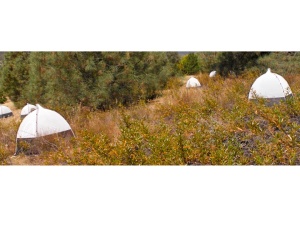Nesting is a key feature of native bee biology. Bees are central-place foragers, returning from their foraging trips with pollen and nectar for their young. Yet despite it’s importance, nesting has been challenging to study. Not only do most bees nest in the ground, but their nests can be hard to find- they might be hidden under plant roots, or tucked in the side of a crack in the soil. Even the rounded holes bees create as their tunnel entrances often look like holes made by other insects. So what’s a melittologist to do?
I just published a paper in Basic and Applied Ecology on a novel adaptation of emergence traps (they look a lot like REI model tents- see picture below) to examine native bee nesting. And I found some interesting things using them. For example, I found native bees mostly nested in areas where the ground had steeper slopes. I also found that bare ground was key for nesting. But surprisingly, I didn’t find any soil characteristics, like percent sand silt clay, or organic matter content, that influenced nesting. My study was conducted in a natural area, so it is important to test these findings to see if they hold true in agricultural areas. And that’s exactly what I’ll be looking at next.
For bee biologists out there- I also compared e-traps to 2 other known sampling methods, pan traps and aerial netting. I found that e-traps captured about 14% of the total community, adding 8 species that weren’t collected by other methods. In fact, I found that all three sampling techniques were highly dissimilar, and therefore potentially complimentary. I think e-traps have the potential to help us find more nests and sample landscapes for nesting bees.
Let me know if you have any more questions about my study.
Sardiñas, H.S., and Kremen, C. 2014. Evaluating nesting microhabitat for ground-nesting bees using emergence traps. Basic and Applied Ecology 15: 161-168.


